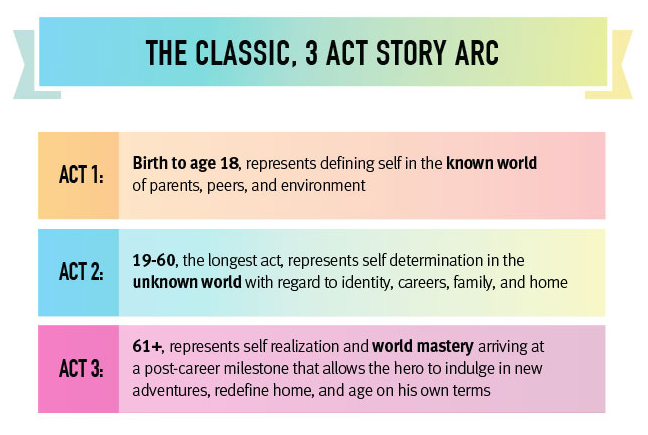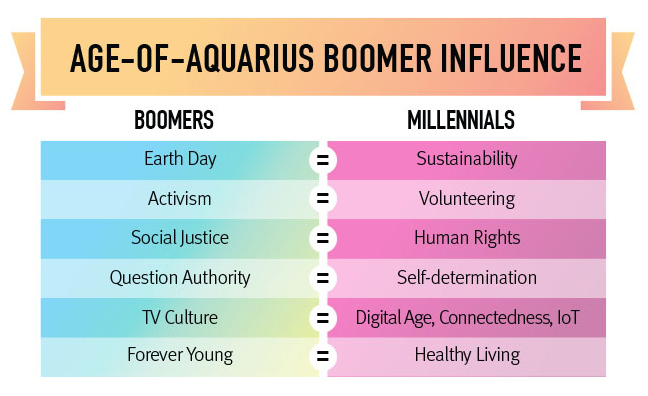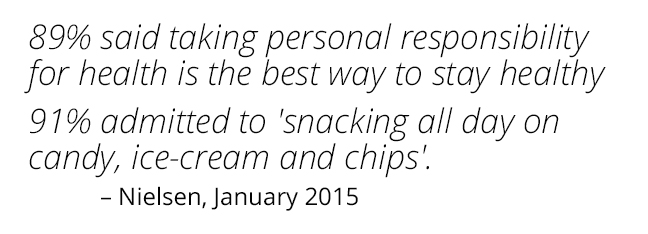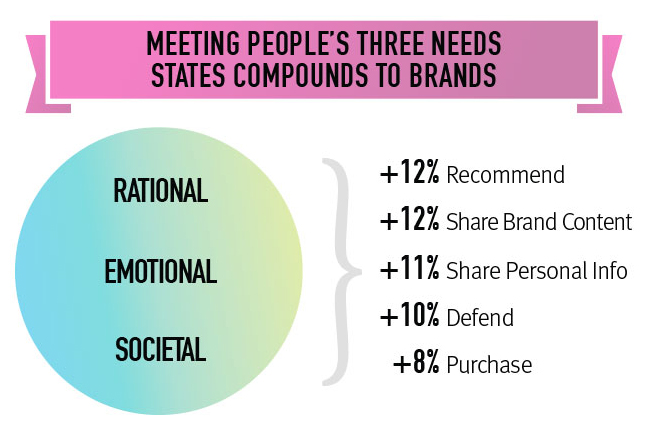
As marketers, we strive to learn everything there is to know about Millennials, Gen Xers, and the ever-evolving Baby Boomers. We’re great at segmenting, and slicing and dicing data captured from consumers until it looks like a Panera chopped salad bearing little resemblance to its origins. While useful, these details don’t help us to set the course of consumer marketing plans and goals. They’re simply too specific.
Each of the generational groups is defined by a “point of birth” that spans 20 years. The stage-of-life needs of a 51-year-old Baby Boomer are quite different from his 70 year-old counterpart, so targeting “Boomers” is not really targeting at all. What is more useful than a generational approach to group marketing is considering a time of life, or life milestone, the age group may be facing. These points in time, and rights of passage are common to us all.
Where to start. First and foremost, we set a baseline of what we all have in common, regardless of generation, i.e. the human condition, fundamental human behaviors, and common concerns. What we have in common provides context for building individual consumer experiences later on when paired with the limitless individual information floating in our data lakes.
Here are a few fundamental beliefs and causes we can agree are common to us all:
- Denim is the fabric of our lives,
- Graphic tees are a wardrobe imperative.
…and, we share concern throughout our lives for various aspects of:
- Self Improvement
- Social Justice
- Sustainability
- Health
Consumer behavior using the classic 3 Act Story Arc
My classifications follows the classic story arc of a hero in movies or literature that traditionally breaks down into 3 Acts.
Applied 3-Act, time-of-life thinking
Self Improvement, for example, is such a big topic that it becomes meaningless without more context. Working from very big generalities down to specifics, I find it much more useful to think about the relevance of self improvement to a time of life, like retirement, rather than a time of birth, like Baby Boomer.
Why is time of life more useful than time of birth in describing our hero? Because time of life represents challenges and considerations that are specific to that age, and no other. Take Baby Boomers – a classification that describes an expanse of roughly 20 years (1946-64), and evokes images from Hippies burning draft cards in the late 60s, to seniors in their late 60s cashing SS checks – very different ways of interacting with Federal documents, and possibly the same people. When we look at Third Act challenges, however, we get a very specific set of concerns that brands might be able to assist with.
The Age-of-Aquarius Boomer behaviors and beliefs refuted their parents’ thinking, and defined a sensibility that has been passed down, and is now shared across subsequent generations:
Another acknowledgement of generational overlap comes from George Ergatoudis, Head of Music, BBC Radio 1,
Same concerns, only different
With all that overlap, creating a consumer profile should be easier now, right. Not so fast. It seems as much as we are the same, we are equally different.
For example, throughout our lives, we are concerned with health – but the focus changes. Therefore, creating engaging products, and customized experiences across life’s 3 acts might focus on time of life challenges like these:
- Act 1 (birth to 18): Bullying, Healthy eating, Fitting in
- Act 2 (19 to 60) : Fitness, Getting married, Stress management
- Act 3 (61+): Building strength, Socializing, Elder learning
Smart customization of targeted products and programs that reward and engage users socially and in real time will be successful. Those that simply acquire data, will fall by the wayside. Engagement, reward, motivation – are essential components of insightful innovation.
Making it personal
Combining fundamental behaviors, time-of-life challenges, and the ever-expanding data for each and every consumer, The One to One Future, forecast in the 1993 book by the same name, is finally here. How do we embrace post-demographic consumerism, especially with belief/behavior contradictions like these?
As much as we love to lean on data, we must remember that statistics are the generalizations that arise from grouping selected points in rich and unique life stories. Everyone’s experiences are different and actually defy generalization. Our ability to capture the unique information, consider it in a marketing plan designed to engage consumers, then act on it for the benefit of each individual, creates the intersection where we can expect growth in both business and loyalty.
Speaking of loyalty…
One study of consumer attitudes toward brands, Brandshare 2014, had the following to say:
Seventy percent of people around the world believe brands’ motivations to share is based upon self-centered desires to increase profits, rather than part of a sincere commitments to their customers.
People are clear in their demands for greater access to brands and a better understanding of brands’ convictions, while giving brands low grades in the behaviors they ranked as most important: access, involvement and conviction.
Summary
Increasingly, brands are taking the lead in addressing controversies, such as violence against women by NFL players or racist comments by former Los Angeles Clippers owner Donald Sterling. Brands also do well by taking on important issues, such as Unilever’s hand-washing campaign for Lifebuoy soap. The democratic process inherent in consumer choice will only drive change faster.
Now what?
We’re in a post-demographic era where what we thought we knew about certain groups no longer applies because consumers are defining and redefining themselves without us (how inconvenient). The not-so-old way of grouping people into their generational and income categories as a way to define and appeal to them is illogical for the many reasons already presented.
Our alternatives show you the ways we’ve been successful in helping brands find their way through the confusing new world disorder.
Consumer behavior profiling
- Evaluate human behaviors common to all,
- Define challenges linked to milestones that occur in the life-story arc of 3 Acts,
- Use the hyper-specific behavior data of individuals to form insights,
- Innovate – create brand connections by providing consumers with something engagingl, something that makes life easier, something that rewards them with what they value.
These 4 steps combine to form the foundation for creating brand/consumer connections in the post-demographic world.
Finding and applying insights from data like this is the beginning of finding new ways to reach, appeal to, and help consumers solve problems. To all those brands struggling to define who they should be talking to, what they should say, and how to stay relevant, we say join us. We’d love to help you, let’s figure it out together.






